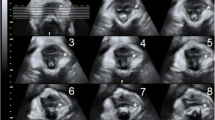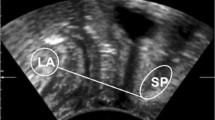Abstract
Purpose
To compare the correlation between 2D transperineal ultrasonography and physical examination (intravaginal palpation) for assessing pelvic floor and levator ani function.
Methods
Due to symptoms of pelvic floor disorder, 40 women between the ages of 29 and 75 were enrolled in this study as candidates for urodynamic and structural evaluation of the pelvic floor. A pelvic floor gynaecologist and radiologist assessed the levator ani function via physical examination (graded based on the Oxford Grading System) and transperineal 2D ultrasound, respectively.
Results
The ultrasound parameters for calculating the Levator Ani Index (LAI) demonstrate a difference between the anteroposterior dimension of the levator hiatus (r = 0.691, p < 0.001) and the cranial shift of muscle (r = 0.499, p < 0.001) at rest and during a squeezing manoeuvre in the mid-sagittal plane. Reduced anteroposterior diameter of the hiatus and increased cranial shift were associated with a higher Oxford Physical Examination Score (OPES). The association between LAI and OPES was independent of baseline variables such as age, BMI, number of births, and the presence of incontinence symptoms.
Conclusion
Measures such as the LAI can be used to quantify the function of the levator ani muscle, which may be useful for evaluating the efficacy of pelvic floor physiotherapy and exercise.





Similar content being viewed by others
Data availability
Related data is available from corresponding author upon reasonable demand.
Abbreviations
- PFM:
-
Pelvic floor muscles
- SD:
-
Standard deviation
- LAI:
-
Levator Ani Index
- BMI:
-
Body mass index
- OPES:
-
Oxford Physical Examination Score
References
Shafik A, El-Sibai O (2002) Study of the levator ani muscle in the multipara: role of levator dysfunction in defecation disorders. J Obstet Gynaecol 22:187–192
Arbuckle JL, Parden AM, Hoover K, et al. Prevalence and awareness of pelvic floor disorders in female adolescents seeking gynecologic care. J Pediatr Adolesc Gynecol. 2019;32:288–92.
Bø K, Finckenhagen HB (2001) Vaginal palpation of pelvic floor muscle strength: inter-test reproducibility and comparison between palpation and vaginal squeeze pressure. Acta Obstet Gynecol Scand 80:883–887
Romero-Cullerés G, Peña-Pitarch E, Jané-Feixas C et al (2017) Intra-rater reliability and diagnostic accuracy of a new vaginal dynamometer to measure pelvic floor muscle strength in women with urinary incontinence. Neurourol Urodyn 36:333–337
Aw HC, Ranasinghe W, Tan PHM et al (2017) Overactive pelvic floor muscles (OPFM): improving diagnostic accuracy with clinical examination and functional studies. Transl Androl Urol 6:S64–S67
Tubaro A, Koelbl H, Laterza R et al (2011) Ultrasound imaging of the pelvic floor: where are we going? Neurourol Urodyn 30:729–734
Dietz HP (2010) Pelvic floor ultrasound: a review. Am J Obstet Gynecol 202:321–334
Thompson JA, O’Sullivan PB, Briffa K et al (2005) Assessment of pelvic floor movement using transabdominal and transperineal ultrasound. Int Urogynecol J 16:285–292
Peng Q, Jones R, Shishido K et al (2007) Ultrasound evaluation of dynamic responses of female pelvic floor muscles. Ultrasound Med Biol 33:342–352
Jamard E, Blouet M, Thubert T, et al. Utility of 2D-ultrasound in pelvic floor muscle contraction and bladder neck mobility assessment in women with urinary incontinence. J Gynecol Obstet Hum Reprod. 2020;49(1):101629. https://doi.org/10.1016/j.jogoh.2019.101629. Epub 2019 Sep 6. PMID: 31499282.
Albrich S, Steetskamp J, Knoechel S-L et al (2016) Assessment of pelvic floor muscle contractility: digital palpation versus 2D and 3D perineal ultrasound. Arch Gynecol Obstet 293:839–843
Lone F, Thakar R, Sultan A et al (2012) Accuracy of assessing pelvic organ prolapse quantification points using dynamic 2D transperineal ultrasound in women with pelvic organ prolapse. Int Urogynecol J 23:1555–1560
Funding
This research did not receive any specific grant from funding agencies in the public, commercial, or not-for-profit sectors.
Author information
Authors and Affiliations
Contributions
All authors contributed to the study conception and design. Material preparation, data collection and analysis were performed by AA, ZG, SR, MA-A, SNMY. The first draft of the manuscript was written by SR and all authors commented on previous versions of the manuscript. All authors read and approved the final manuscript.
Corresponding author
Ethics declarations
Conflict of interest
The authors declare that there is no conflict of interest.
Ethical statements
The study was approved by institutional ethics committee and all the patients signed an informed written consent before their participation.
Consent to publish
The authors affirm that research participants provided informed consent for publication of the images in Figs. 2 and 3.
Additional information
Publisher's Note
Springer Nature remains neutral with regard to jurisdictional claims in published maps and institutional affiliations.
Rights and permissions
Springer Nature or its licensor (e.g. a society or other partner) holds exclusive rights to this article under a publishing agreement with the author(s) or other rightsholder(s); author self-archiving of the accepted manuscript version of this article is solely governed by the terms of such publishing agreement and applicable law.
About this article
Cite this article
Arian, A., Ghanbari, Z., Rasoulighasemlouei, S. et al. Association between 2D trans-perineal ultrasound and physical examination in evaluation of ani function. J Ultrasound 26, 423–428 (2023). https://doi.org/10.1007/s40477-023-00776-6
Received:
Accepted:
Published:
Issue Date:
DOI: https://doi.org/10.1007/s40477-023-00776-6




